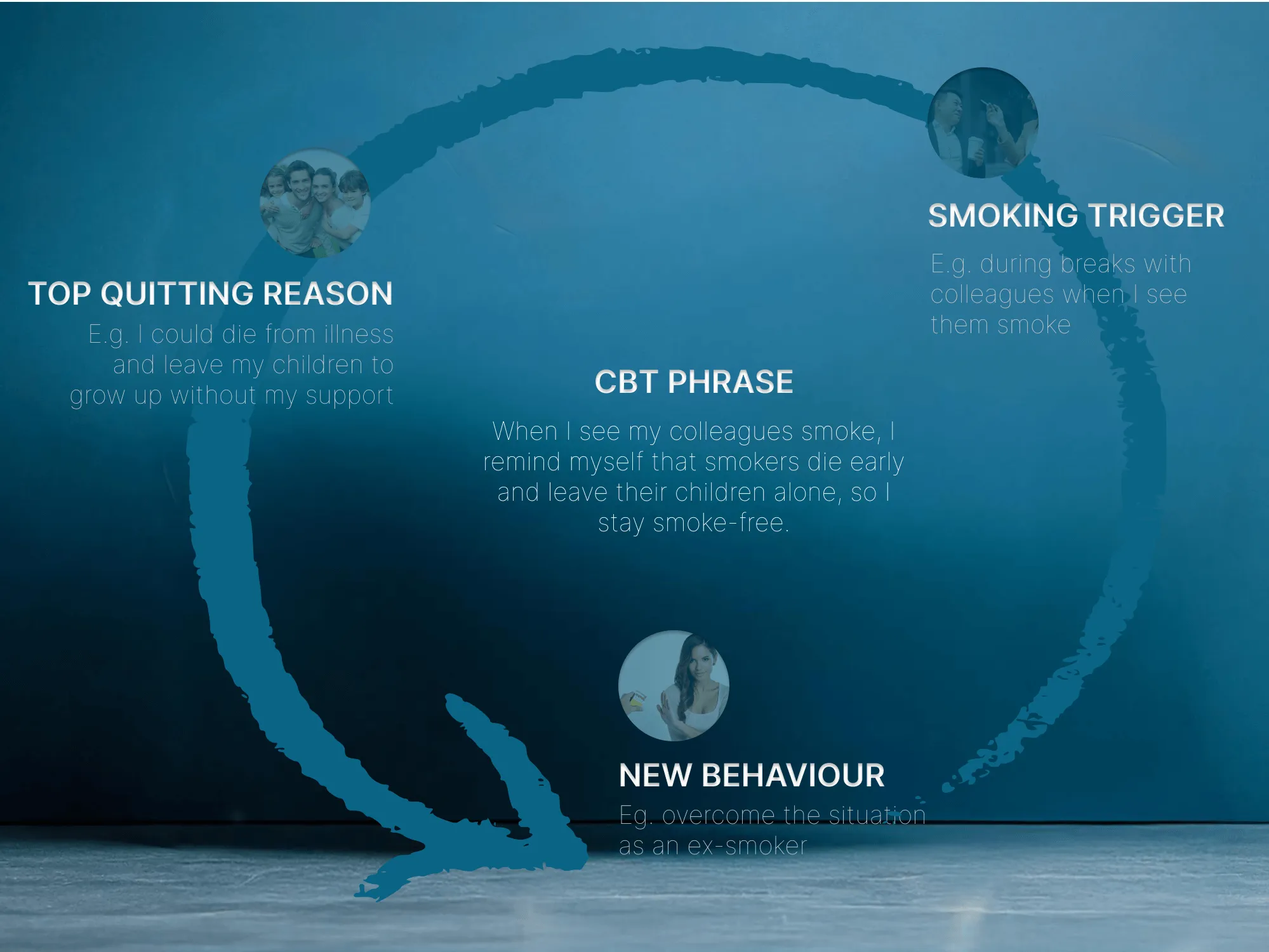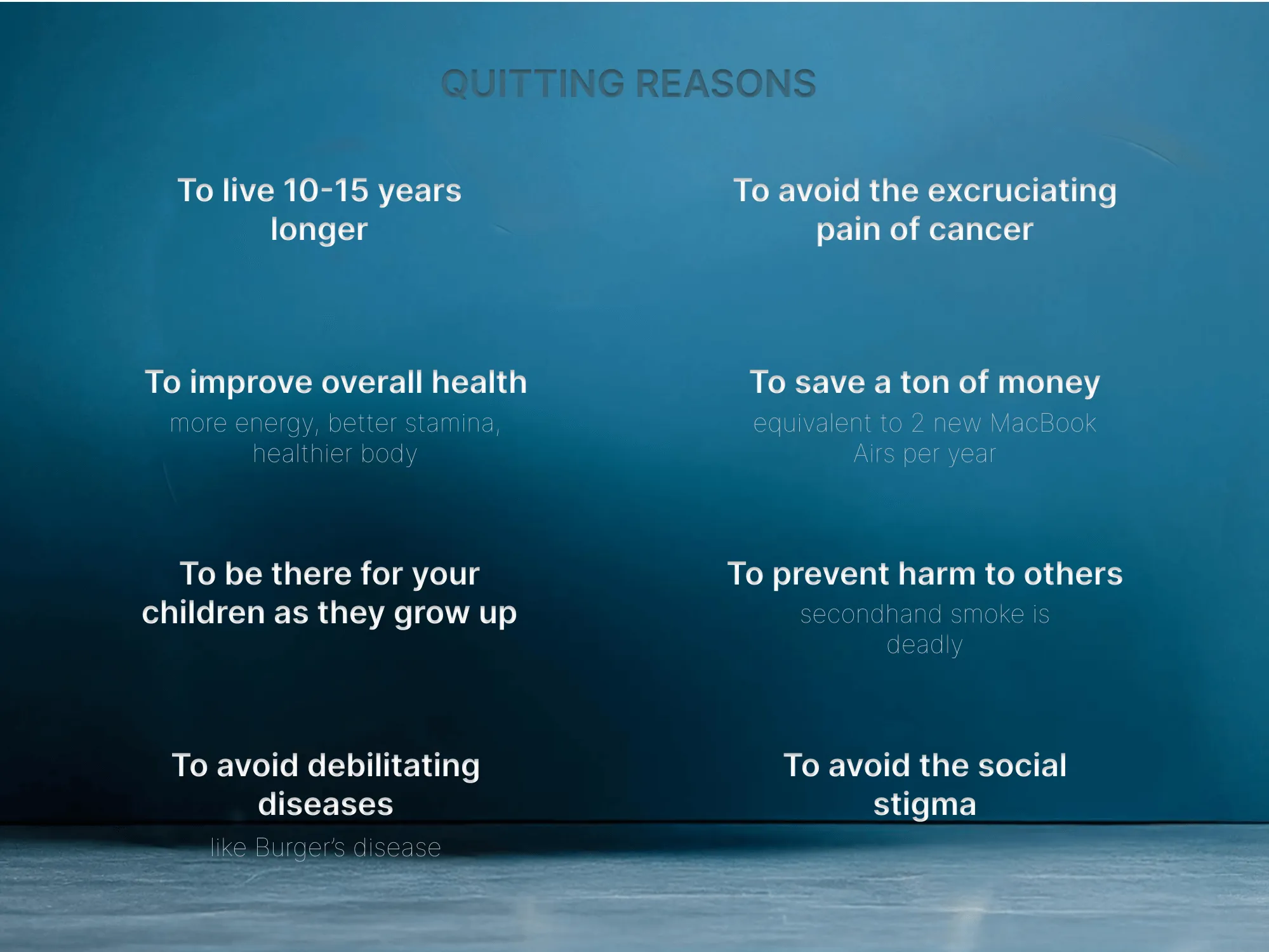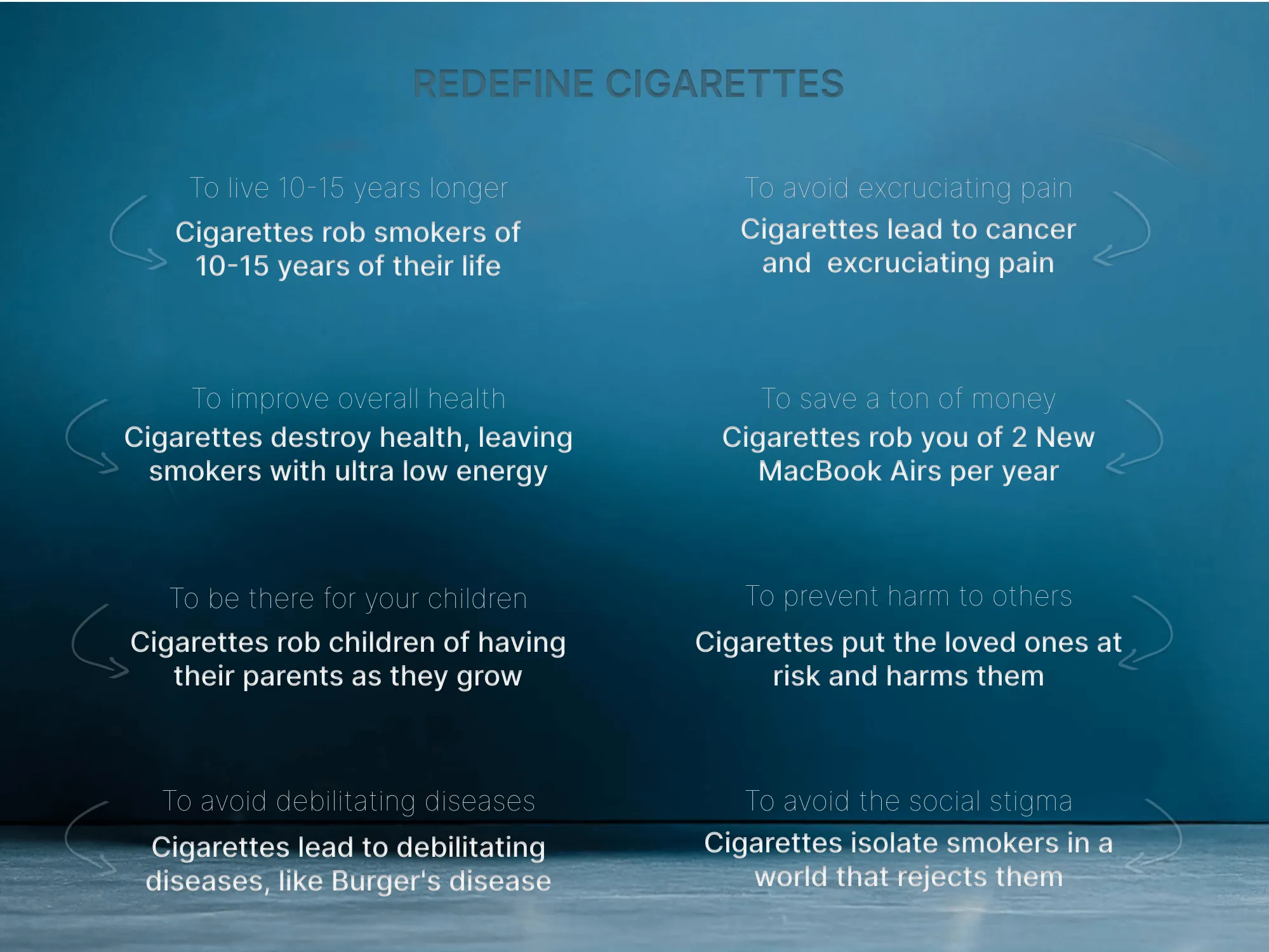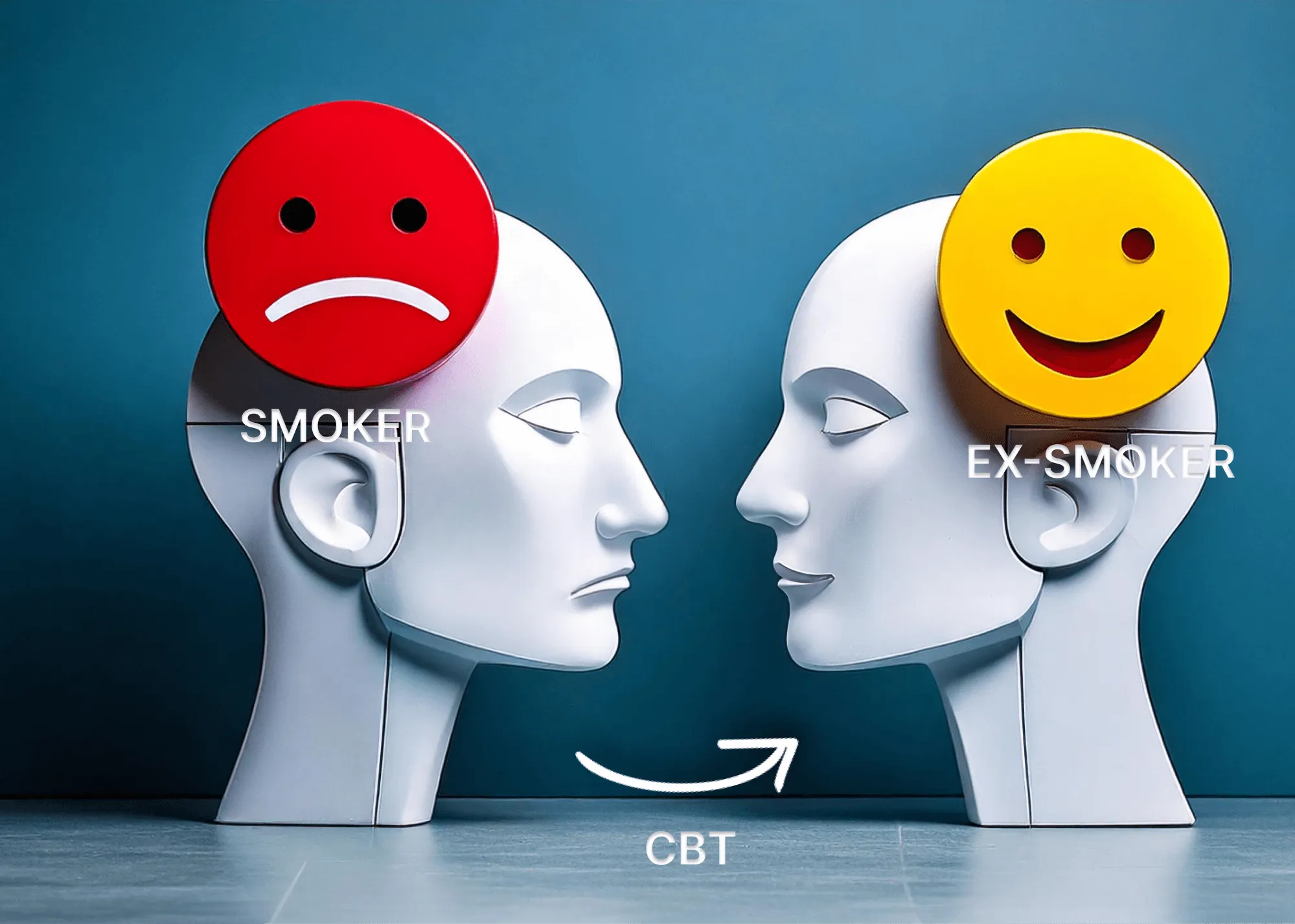Break the Smoking Habit Using CBT
Learn how easy it is to break the smoking habit for good with Cognitive Behavioral Therapy (No Willpower Needed).
Daniel Stefan
Jan 19, 2025
7 min read

You read Allen Carr’s Easyway to Stop Smoking, hoping it would unlock the secret. You even tried nicotine receptor-blocking pills, trusting that science might have the answer. Maybe you patched up, chewed the gum, or relied on pure willpower.
If that’s your story, I get it because I’ve walked the same path.
After 13 years hooked on cigarettes and nearly a decade of failed attempts to quit, I knew that frustration all too well. Nothing seemed to stick. So, out of pure desperation, I created a structured quit smoking program—a simple, daily practice that finally helped me break the smoking habit for good.
One of the methods in this program was the "If this happens, I do that" strategy. It’s a straightforward, trigger-based response system borrowed from marketing, psychology, and cognitive behavioral therapy (CBT). This approach rewires how you react to smoking triggers, helping you replace the urge to smoke with healthier actions.
This method isn’t certified by any official CBT program, but it worked for me—a heavy smoker drowning in cravings. And if it worked for me, it can work for you too.
How did I apply CBT to break the smoking habit for good?
Here’s exactly how I applied this method to break the smoking habit:
1. Identified My Smoking Triggers
I started by making a list of situations where I felt the strongest urge to smoke. For example:
- When I am at a client’s office and the client lights a cigarette...
- When I am with a friend and my friend lights a cigarette...
- When I am with a friend and my friend lights a cigarette...
- When I am with friends and a friend lights a cigarette...
2. Clarified My Most Impactful Reason to Quit
I focused on the ultimate motivation driving my desire to quit: avoiding cancer and the prospect of an early, painful death. This became my anchor, a powerful reminder in moments of temptation.
3. Negatively Redefined what Cigarettes Mean
By starting with the most impactful reason to quit, I negatively redefined cigarettes: “cigarettes are generating cancer and excruciating pain”.
4. Defined a new behavior
I defined a new behavior to override my old habit of lighting a cigarette. In those triggering moments, I committed to refraining from smoking.
5. Crafted a CBT phrase to program myself to quit smoking
When trigger happens > I negatively associate the cigarettes > and display the new behavior.
One example: "When I’m at a client’s office and they light a cigarette, I immediately remind myself that cigarettes generate cancer and excruciating pain. As a result, I successfully overcome the moment as a non-smoker."

6. Daily filled a new paper with the phrase
Each day, I dedicated time to writing the phrase repeatedly on a sheet of Letter paper. Depending on the day, I might have written more or fewer repetitions, but the goal was always the same—fill the page. Over time, this daily practice reinforced the thought in my mind, making it second nature.
To ensure I addressed all possible triggers, I cycled through various scenarios, always following the same structure: Trigger – Negative Association – New Behavior.
7. Tracked progress
I created a simple table to track my daily writing practice. Each row marked a date, and I checked off the day once I filled the page. If you track it, you will do it, thus you will succeed!
To sum it all up, I used two things:
1. A phrase structured as “Trigger – Negative Association – New Behavior” to reinforce the new habit of overcoming temptation as a non-smoker.
2. A table to track daily progress and ensure consistency.
How does this CBT method work?
The above method is a practical example of Cognitive Behavioral Therapy (CBT). Specifically, it aligns with the concept of cognitive restructuring, a core part of CBT that helps people change negative thought patterns. In fact, studies show that people who use personalized coping statements and positive reminders like this are more likely to quit smoking for good (1, 2).
Here's how it works:
Identifying Smoking Triggers:
The first step is to recognize the situations, environments, or emotions that spark your cravings. For example, being at a client’s office where someone lights a cigarette. By identifying your triggers, you can prepare mentally for these moments.
Recognizing Automatic Thoughts:
Triggers often bring up automatic thoughts like “I need a cigarette to relax.” These thoughts feel natural but are unhelpful. Becoming aware of these patterns is the first step toward breaking them.
Replacing Unhelpful Thoughts with Positive Associations:
Instead of giving in to cravings or nostalgia for smoking, replace those thoughts with rational, health-focused ones. For instance, remind yourself, “Cigarettes cause cancer and pain, and I’m better off without them.” This new thought helps weaken the connection between the trigger and the urge to smoke.
Shifting Emotional Response:
Reframing your thoughts also changes how you feel about smoking. By focusing on the harmful effects of cigarettes, you replace any lingering appeal with a sense of empowerment and control.
Reinforcing Positive Behaviors:
Each time you successfully navigate a craving as a non-smoker, you reinforce healthier behaviors. Over time, these behaviors become second nature, and the old habits lose their hold. With consistent practice, you’ll not only feel more in control but also find that staying smoke-free becomes easier and more natural every day.
Enough with the theory—let’s dive into the concrete steps you can take to use the CBT method to break the smoking habit effectively.
Steps to Break the Smoking Habit Using the CBT Method
Step 1: Identify Your Smoking Triggers
Start by making a list of all the situations, emotions, or environments that make you want to smoke. Everyone’s triggers are unique, but here are some common examples for inspiration:
- When I’m at a client’s office and they light a cigarette.
- During breaks at work when a colleague smokes nearby.
- While hanging out with friends who smoke.
- When I feel the urge to smoke, triggered by stress or routine habits.
- Action: Write these triggers on a piece of paper so you can address them individually.
Action: Write these triggers down on a piece of paper so you can address them individually. This will help you be prepared when you encounter these situations.

Step 2: Find Your Most Important Reason to Quit Smoking
Identify your most important “why”—the core reason that drives your desire to quit. This will serve as your anchor during moments of temptation, reminding you why it’s worth pushing through. Motivation is one of the key factors that will influence your success in quitting smoking (3, 4).
Examples:
- For me, it was my desire to avoid cancer and the excruciating pain I’ve seen others endure.
- For my wife’s friend, Maria, it was the thought of leaving her child alone if she died from smoking.
Action: Reflect deeply and write down the most important reason for you to quit smoking. This reason should be so compelling that it overrides the temptation to smoke.

Step 3: Negatively Redefine What Cigarettes Mean
Once you’ve identified your primary reason to quit, use it to negatively redefine cigarettes. This involves associating smoking with a painful consequence that motivates you to resist.
For example:
- "Cigarettes generate cancer and excruciating pain."
- "Cigarettes steal 10-15 years from a smoker's life."
Action: By starting with your most impactful reason to quit, negatively redefine what cigarettes mean to you. This association will strengthen your resolve to avoid smoking.
Step 4: Define a New Behavior
In those triggering moments, commit to refusing cigarettes and acting as an ex-smoker, reinforcing your new identity.
Some people suggest replacing the act of smoking with other behaviors—like chewing gum, drinking water, or going for a walk. But I wouldn’t recommend this if you’re not a professional clown. The true, natural behavior of a non-smoker isn’t about doing somersaults or performing a dance routine in front of others. The real, authentic behavior is simply to stay away from cigarettes.
Trust me, the most powerful move you can make is to stand there, calmly, and choose not to smoke. The silence of your decision will speak volumes—it’s far more shocking and impressive in the long term than trying to distract yourself with gimmicks. Just stay in the moment, and own the fact that you are now an ex-smoker.
Step 5: Write Down the CBT Phrase for Each Trigger
For every trigger, craft a phrase using this structure: When [trigger], I immediately remind myself of the negative side effects of smoking, and I overcome the situation as a non-smoker.
Examples:
- “When I’m on a break and a colleague lights a cigarette, I instantly remind myself that cigarettes cause cancer and excruciating pain. As a result, I successfully overcome the moment as a non-smoker.”
- “When I’m out with friends and someone lights a cigarette, I remind myself that smoking leads to cancer and pain. I successfully navigate the moment as a non-smoker.”
- “When I feel the urge to smoke, I remember that parents who smoke may leave their children alone. I overcome the moment as a non-smoker.”
Action: Write down these personalized phrases for each trigger. These will serve as your mental blueprint for handling cravings.
This approach is supported by research showing that reinforcing personal commitment to change significantly improves smoking cessation outcomes (5,6).
Step 6: Daily Fill a Letter Paper with Your CBT Phrase
Each day, dedicate time to writing your phrase repeatedly on a sheet of letter paper, cycling through your smoking triggers. The goal is to reinforce the association between the trigger, negative outcome, and new behavior. The more often you write it, the more ingrained the thought becomes, turning it into a second nature response.
Action: Fill a page each day with your CBT phrase. Think of it like the story of the guy who stopped digging just 6 meters away from gold. At first, the progress may not seem monumental, but every written repetition of your CBT phrase is like one more swing of the pickaxe, bringing you closer to the prize. Just keep going, and the quitting gold medal is yours!
Step 7: Be Consistent and Track Your Progress
Action: Create a simple table to track your daily progress. Include two columns: Date: Write the date for each day you practice. Checkmark: Mark it once you’ve filled a page with your phrases.
Consistency is key. Focus on practicing this method every day, rather than worrying about how quickly you’ll quit. For some people, it takes as little as 2 weeks to quit smoking entirely. Others, like myself, may need 2-3 months. Don’t focus on quitting or a specific timeline. Instead, focus on applying the method daily. Trust the process, and success will follow.

Conclusion
Since 2013, I’ve enjoyed over 12 years of being smoke-free. Quitting smoking isn’t just something you check off a to-do list—it’s a life-changing milestone. It’s the foundation for a healthier, stronger version of yourself and the first step toward a brighter future.
The reason behind creating this website and writing these articles goes far beyond promoting the BravoBee Zero Willpower Quit Smoking Program. It’s deeply personal. I was once desperate to overcome my addiction, trying everything I could—medications, books like Allen Carr’s Easyway to Stop Smoking, and countless pieces of advice—but nothing truly worked for me. That’s why BravoBee exists: to provide you and others with the knowledge and tools you need to quit smoking for good.
The truth about smoking is harsh—according to the American Academy of Family Physicians (AAFP), unassisted quit rates are as low as 3% to 5%. The rest face devastating consequences: living 10 years less or, even worse, succumbing to painful, life-altering diseases (7, 8). But this doesn’t have to be your story.
By applying the custom CBT method, you have a real and powerful chance to break free from smoking forever. Start small: grab a piece of paper, list your triggers, find your most compelling reason to quit, and write down your “Trigger – Negative Association – New Behavior” phrases, as outlined in this article. Begin today—your future self will thank you.
I know this works because I’ve done it. I’ve walked the path you’re about to take, and it led me to a life I once thought was out of reach when I was stuck in the habit. If I could do it, so can you.
Start using the CBT method today, and take your first step toward a smoke-free, healthier life. You’ve got this!
Studies:
(1) "Cognitive-Behavioral Therapy for Smoking Cessation: A Meta-Analysis of Randomized Controlled Trials" Findings: This meta-analysis found that Cognitive-Behavioral Therapy (CBT) interventions significantly increased smoking cessation rates compared to control conditions. Techniques such as developing personalized coping statements to manage triggers were highlighted as effective components of the therapy. Reference: Myers, M. G., & Brown, S. A. (2000). Journal of Consulting and Clinical Psychology, 68(4), 690–702.
(2) "Cognitive-Behavioral Therapy for Smoking Cessation: A Randomized Controlled Trial" Findings: This study demonstrated that participants receiving CBT, which included the creation of individualized coping statements for smoking triggers, had higher quit rates compared to those receiving standard care. The use of these personalized statements was associated with improved smoking cessation outcomes. Reference: Munoz, R. F., et al. (1997). Journal of Consulting and Clinical Psychology, 65(4), 659–667.
(3) Predictors of Smoking Cessation Attempts and Success Following Motivation-Phase Interventions Among People Initially Unwilling to Quit Smoking Findings: This study found that predictors of making a quit attempt differed from predictors of quitting success. Specifically, increasing the time to first cigarette and quitting self-efficacy were associated with making quit attempts, while motivation to quit was linked to quit success. Reference: Klemperer, E. M., Mermelstein, R., Baker, T. B., Hughes, J. R., Fiore, M. C., Piper, M. E., Schlam, T. R., Jorenby, D. E., Collins, L. M., & Cook, J. W. (2020). Nicotine & Tobacco Research, 22(9), 1446–1452.
(4) Predictors of attempts to stop smoking and their success in adult general population samples: A systematic review.
Findings: This systematic review found that high motivation to quit smoking was a consistent predictor of making a quit attempt and achieving success. Motivation, especially when intrinsic, significantly increases the likelihood of sustained smoking cessation. Reference: Vangeli, E., Stapleton, J., Smit, E. S., Borland, R., & West, R. (2011). Addiction, 106(12), 2110–2121. https://doi.org/10.1111/j.1360-0443.2011.03565.x
(5) "Telephone-Delivered Acceptance and Commitment Therapy for Adult Smoking Cessation: A Randomized Controlled Trial" Findings: This study demonstrated that participants receiving Acceptance and Commitment Therapy (ACT), which emphasizes personal values and commitment to change, had higher quit rates compared to those receiving standard care. The incorporation of commitment strategies was associated with improved smoking cessation outcomes. Reference: Bricker, J. B., et al. (2014). Nicotine & Tobacco Research, 16(11), 1446–1454.
(6) "Acceptance and Commitment Therapy for Smoking Cessation: A Preliminary Study of Its Effectiveness in Comparison with Cognitive Behavioral Therapy" Findings: This preliminary study found that ACT, which includes commitment to personal values and behavior change, was as effective as Cognitive Behavioral Therapy (CBT) in promoting smoking cessation. The emphasis on personal commitment in ACT was beneficial for participants' quitting success. Reference: Hernández-López, M., et al. (2009). Psychology of Addictive Behaviors, 23(4), 723–730.
(7) 21st-Century Hazards of Smoking and Benefits of Cessation in the United States Findings: Smokers lose at least 10 years of life expectancy. Quitting before the age of 40 reduces the risk of death from smoking-related causes by about 90%. Reference: Jha, P., Ramasundarahettige, C., Landsman, V., Rostron, B., Thun, M., Anderson, R. N., McAfee, T., & Peto, R. (2013). New England Journal of Medicine, 368(4), 341–350. https://doi.org/10.1056/NEJMsa1211128
(8) Title: Nicotine Replacement Therapy for Smoking Cessation Findings: This Cochrane systematic review assessed the effectiveness of Nicotine Replacement Therapy (NRT) compared to placebo or no treatment in aiding smoking cessation. The study highlights that unassisted quit rates (cold turkey) are low, around 3% to 5%, whereas NRT significantly improves quit rates. Reference: Stead, L. F., Perera, R., Bullen, C., Mant, D., Hartmann-Boyce, J., Cahill, K., & Lancaster, T. (2012). Nicotine Replacement Therapy for Smoking Cessation. Cochrane Database of Systematic Reviews, (11), CD000146. DOI: 10.1002/14651858.CD000146.pub4